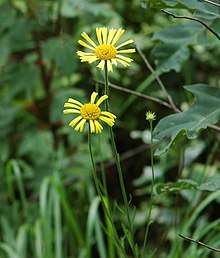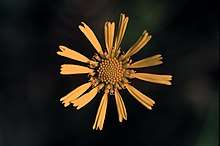Balduina uniflora
Balduina uniflora (commonly called oneflower honeycombhead[2][3], savannah honeycombhead[4] or oneflower balduina[5]) is a North American species of plants in the sunflower family. It is native to the southeastern United States (Louisiana, Florida, Georgia, Alabama, Mississippi, South Carolina, North Carolina).[6] It is the type species of Genus Balduina[7].
| Balduina uniflora | |
|---|---|
 | |
| Two Balduina uniflora flower heads, and one immature flower head. Photo credit: Larry Allain, U.S. Geological Survey | |
| Scientific classification | |
| Kingdom: | |
| (unranked): | |
| (unranked): | |
| (unranked): | |
| Order: | |
| Family: | |
| Genus: | |
| Species: | B. uniflora |
| Binomial name | |
| Balduina uniflora | |
| Synonyms[1] | |
Balduina uniflora is a perennial herb with branching stems. Each plant has 1-4 flower heads, each with 8-22 yellow ray florets and 50-180 orange or yellow disc florets. The species grows in wet pinelands[4] and savannahs,[8] as well as wetland areas and on the edges of bogs[7][2] and tends to occur in wet drainage ditches and on roadsides.[4]
Description
Balduina uniflora is a perennial herbaceous plant and can grow to be 0.4 to 1 meter tall.[7][3] It has fibrous roots and erect stems, and the stems are ribbed.[4] Stems also tend to be branched, except for those that bear flower heads.[7] Leaves, stems, involucres, and peduncles are green and pubescent, except for the bottoms of leaves which may be glabrous or with only sparse hair.[9] Leaves are alternate and tend to be clustered at the base of the plant, getting smaller and more sparse as they reach the apex.[9]

Like other members of family Asteraceae, the "flowers" of this species are actually inflorescences called flower heads, composed of hundreds of individual flowers.[10] The inflorescence has many bracts at its base forming a green bell-shaped or hemispheric incolucre.[11] The yellow petal-like ray florets are sterile and tend to have 3-5 lobes at the edge.[11] The more central disc florets are perfect, containing several arrow-shaped stamen as well as a pistil made up of two ovaries.[7] Each pistil has a yellow[9] two-branched style which extends out of the floret.[7] The plant gets its name from characteristic honeycomb-like bract structures (chaff[11]) most visible at fruit maturity.[7]
Also like others in the Asteraceae family, B. uniflora bears achene-like cypselae: dry, indehiscent fruits with a single seed that develops from the two carpals of the flower.[9][10] This fruit is generally 1.3-2.2mm in length.[9]
This species differs from others in the genus Balduina by its wider corolla rays,[7] larger pollen grains,[7] and by having chromosome arrangement of n=36 rather than n=18 in other species.[7]
Cultivation
Balduina uniflora is not usually a commercially available species, but may be grown from seeds for ornamental purposes in native wildflower gardens.[4] The species prefers wet and boggy soils as well as high levels of sunlight.[4]
Possible polyploidy
A 1975 study of Balduina conducted by Earl S. Parker and Samuel B. Jones[7] found a chromosomal arrangement of n=36 in B. uniflora collected across 16 different areas, which differed from the n=18 arrangement of the other two species in the Balduina genus, leading to the theory that the species is a widespread polyploid.[7] No assumptions as to whether this chromosomal arrangement was allopolyploid or autopolyploid in origin were made.[7]
Ecology
Balduina uniflora is currently not listed by the IUCN Red List.[12]
This species is listed by the NatureServe organization as "Apparently Secure (S4)" nationwide,[5] but as "Vulnerable (S3)" and "Imperiled (S2)" in North and South Carolina, respectively.[5]
This species is not known to be invasive in any U.S. State.[2]
References
- The Plant List, Balduina uniflora Nutt.
- "Balduina uniflora". Natural Resources Conservation Service PLANTS Database. USDA. Retrieved 28 May 2015.
- "Plants of Louisiana". warcapps.usgs.gov. Retrieved 2020-04-02.
- "Balduina uniflora - Species Page - APA: Alabama Plant Atlas". floraofalabama.org. Retrieved 2020-04-17.
- "NatureServe Explorer 2.0". explorer.natureserve.org. Retrieved 2020-04-17.
- Biota of North America Program 2014 county distribution map
- Parker, Earl S.; Jones, Samuel B. (October 1975). "A Systematic Study of the Genus Balduina (Compositae, Heliantheae)". Brittonia. 27 (4): 355. doi:10.2307/2805514. ISSN 0007-196X.
- Flora of North America, Balduina uniflora Nuttall, Gen. N. Amer. Pl. 2: 175. 1818.
- "Balduina uniflora - FNA". beta.floranorthamerica.org. Retrieved 2020-04-17.
- "Asteraceae | plant family". Encyclopedia Britannica. Retrieved 2020-04-17.
- Radford, Albert E.; Ahles, Harry E.; Bell, C. Ritchie (2010). Manual of the Vascular Flora of the Carolinas. The University of North Carolina Press. ISBN 0-8078-9884-8. OCLC 951808313.
- "The IUCN Red List of Threatened Species". IUCN Red List of Threatened Species. Retrieved 2020-04-16.